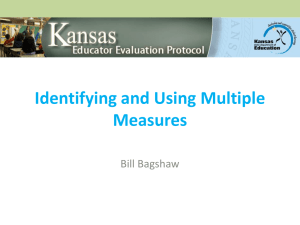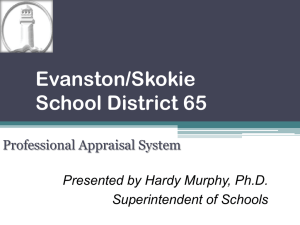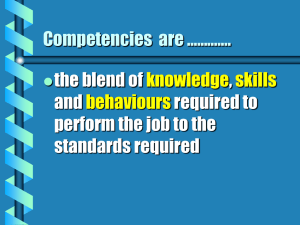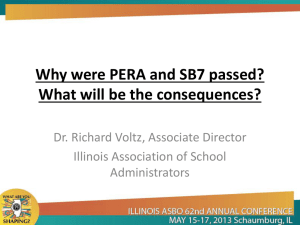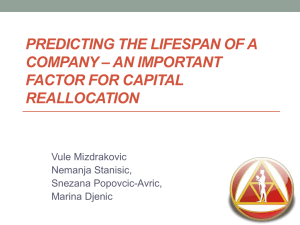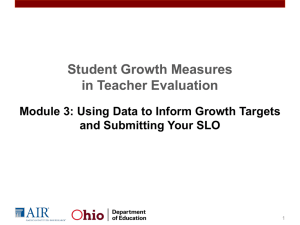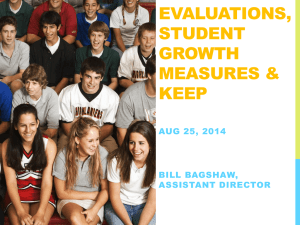Satisfactory - Kansas State Department of Education
advertisement
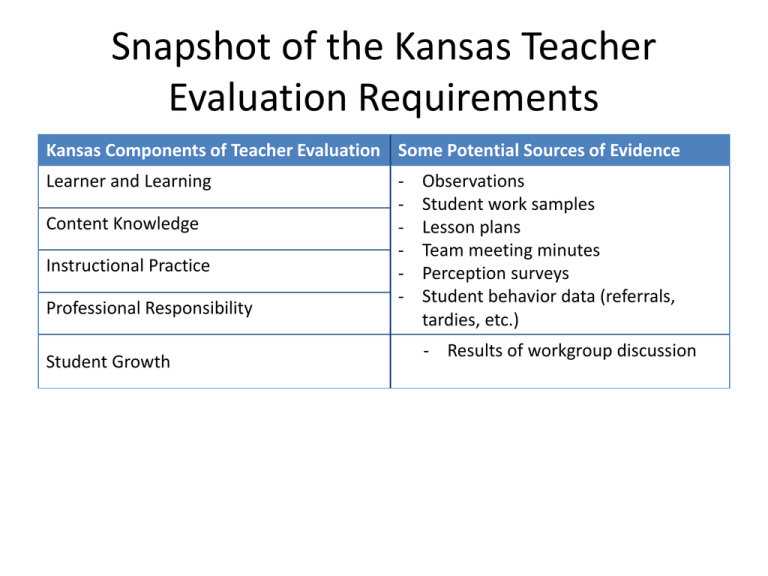
Snapshot of the Kansas Teacher Evaluation Requirements Kansas Components of Teacher Evaluation Some Potential Sources of Evidence Learner and Learning Content Knowledge Instructional Practice Professional Responsibility Student Growth - Observations Student work samples Lesson plans Team meeting minutes Perception surveys Student behavior data (referrals, tardies, etc.) - Results of workgroup discussion The Kansas ESEA Waiver Principle 3 defines student growth as … – Impact on student learning – Measuring the improvement of student’s skills and knowledge What counts as student’s skills and knowledge? – Identify measures of knowledge and skills from list from the field (academic and other) – Non-knowledge and skills measures could fit other components – Additional measures? – Develop criteria for the technical quality for each measure Sample Measures by KSDE from the Field Academic Measures – State Assessments • History and Government State Assessment • ESOL State Assessment • Reading State Assessment • Mathematics State Assessment • Science State Assessment • Writing State Assessment Academic Measures – Not State Assessments Other Student Knowledge and Skills Measures Common Academic Assessments • ACT/SAT scores • Aimsweb • AP scores • CETE Formative Assessments • DIBELS • District wide Common Assessments • Fitness Grams • Lexile Scores • Measures of Academic Progress (MAP) College and Career Ready Measures • Industrial Certifications assessments (Technical Skills) • Interpersonal communication skills (Interpersonal Qualities) • WorkKeys (Career Interest Development) Other Academic Assessments • Student constructed response with rubric for assessment • KWIET portfolio • Performance based measures • Project Rubrics Other Non Academic Measures • Sportsmanship rubric • Life skills (nutrition, physical activity) • Occupational therapy skills • 21st century skills • Library usage (using library tools to find resources) How is improvement determined using the various measures of student growth (skills and knowledge)? – Categorize measures from list according to type – Provide guidance on appropriate methods for determining growth for each type Growth Measures Guidance Table Growth Measure Type Determining Improvement Example of Teachers in this Category State Assessment – Student growth percentile (SGP) rates provided by KSDE – Assessment performance index (API) for educators provided by KSDE Math and reading teachers in Grades 3-8 High Quality Common/Interim Assessment or Norm Referenced Test (District common assessment, Measures of Academic Progress (MAP), ACT) – If pre and post scores are available could calculate student gains – Set growth or mastery targets (% of students passing) – Student Learning Objectives (SLO) or Student Growth Objectives (SGO) Teachers in grades/subjects that administer MAP Other student learning measures (performance assessments, project based reports, portfolios or collection of student works, measures of 21st century skills, rubrics) – Student Learning Objectives or Student Growth Objectives to determine if growth targets are met First grade teachers or music teachers Example of Guidance for Determining Improvement: State Assessments - Virginia Teachers with SGP data from state assessment data will be rated: • Unacceptable: Less than 50% of students demonstrated low growth • Developing: Less than 65% of students demonstrated high growth and less than 50% demonstrated low growth • Proficient: At least 65% of students demonstrated moderate or high growth • Exemplary: More than 50% of students demonstrated high growth and no more than 10 percent demonstrated low growth. Low growth range: 1-34; Moderate growth range: 35-65; High growth range: 66-99 Example of Guidance for Determining Improvement: State Assessments - Delaware Teachers with state assessment data (DCAS) will be rated: • Unsatisfactory: Less than 35% of a teacher’s DCAS student growth targets are met • Unsatisfactory (with administrator discretion): 35-49% of a teacher’s DCAS student growth targets are met • Satisfactory: 50-64% of a teacher’s DCAS student growth targets are met • Exceeds: 65% or more of a teacher’s DCAS student growth targets are met Growth targets are provided by the Department of Education and are determined based on DCAS instructional scale score growth achieved by “similar students” in the previous two years. Example of Guidance for Determining Improvement: Setting Growth or Mastery Targets - Maryland Proficiency or Mastery Target examples • 80% of students will pass the end of course exam • 50% or more will score a 3 or better on the AP exam Growth Target examples • 100% of my students will progress at one fitness level • 65% of my 1st graders will make projected growth or better on the MAP assessment Example of Guidance for Determining Improvement: Setting Growth or Mastery Targets - Maryland cont. Target Average examples • My psychology students will answer, on average, 80% of the questions correctly on the end of course exam Tiered Targets Based on Initial Assessments: • All high school student enrolled in Pre-Calculus will demonstrate measurable improvement from their preassessment score to their post-assessment score as determined by the following criteria: Level 1: (0 -25%) Level 2: (26 -50%) Level 3 (51 –75%) Level 4 (76 –100%) • Those scoring in Levels 1 –3 will move up at least one level on the post assessment. Those scoring in Level 4 will increase their post assessment score by ½ the distance to 100%. Example of Guidance for Determining Improvement: SLOs/SGOs - Georgia SLOs should be written so that local school evaluators can successfully use the SLO Evaluation Rubric to determine if the teacher’s students met the SLO. • Exemplary (3 pts): Greater than or equal to 90% of students met or exceeded their SLO target and 50% or more of these students exceeded their SLO target. • Proficient (2 pts): Greater than or equal to 80% of students met or exceeded their SLO target. • Developing (1 pt): Greater than or equal to 50% and less than 80% of students met or exceeded their SLO target. • Ineffective (0 pts): Less than 50% of students met or exceeded their SLO target. Example of Guidance for Determining Improvement: SLOs/SGOs – Georgia cont. Sample SLO for Grade 9-12 World History : From September 1-15, 2012 to April 1-30, 2013, all students enrolled in World History will demonstrate measureable growth from the pre measure score to their post measure scores as measured by X District’s pre measure and post measure as follows: • The minimum expectation for individual student growth is based on the formula which requires students to grow by 70% of their potential growth. – Pre measure score + [(100- pre score) * .7] = target score – Students who score 10 points above their target score have exceeded their target. Example of Guidance for Determining Improvement: Rubrics - Virginia Teacher’s student growth objective (SGO) For the current school year, 100 percent of my students will make measurable progress in writing. Students scoring at a “1” will increase by two performance levels. Students scoring at a “2” or “3” will increase by one performance level. Students scoring at a “4” will maintain high performance. Level Baseline (n) Midyear (n) End of Year (n) 1 6 3 2 Did not meet goal 5 17 2 11 11 2 Met goal 19 63 3 10 10 11 Exceeded goal 6 20 4 3 6 15 Number Percent Example of Guidance for Determining Improvement: Rubrics - Virginia cont. The teacher would receive a rating of “proficient” using Virginia’s rating criteria for student achievement goals: • Exemplary: More than 50 percent of students exceeded the goal and no more than 10 percent failed to meet the goal • Proficient: At least 80 percent of students met or exceeded the goal (the percentage of students who exceeded + met goal > 80 percent) • Developing: > 50 percent of students met or exceeded the goal; AND < 50 percent of students failed to meet the goal • Unacceptable: > 50 percent of students failed to meet the goal Example of Guidance for Determining Improvement: Portfolios - Tennessee 1) Teachers will review the Evidence Collection Guide and compile a purposeful sample of student growth samples (a minimum of five Collections of Evidence). 2) Teachers will complete an explanation form that describes how the evidence submitted for each domain shows growth within that domain. 3) Teachers will score each Evidence Collection against the provided scoring guides, on a scale of 1 (Significantly Below Standards) to 5 (Significantly Above Standards). 4) Teachers will submit the completed portfolio to the Blind Peer Review Committee. Example of Guidance for Determining Improvement: Portfolios - New Haven Public Schools • Sample Goal 1: 90% of final portfolio presentations attain the level of “shows significant improvement” or “shows outstanding improvement” on rubric at year-end review. • Sample Goal 2: 80% of “Artist Spotlight” booklet submissions show growth AND achieve a rating of at least “Good” (>40/50) on rubric and are published in our end-of-year famous artist profiles magazine. Sample of Guidance for Determining Improvement: Weighting Student Growth Measures - Delaware Overall Growth Measure Rating Delaware requires two measures of student growth. The state established guidelines for obtaining the Overall Student Learning and Growth measure rating: 1st Growth Measure Rating 2nd Growth Measure Rating Overall Growth Measure Rating Exceeds Exceeds Exceeds Exceeds Satisfactory Satisfactory Exceeds Unsatisfactory Satisfactory Satisfactory Satisfactory Satisfactory Satisfactory Unsatisfactory Unsatisfactory (administrator can upgrade to “satisfactory”) Unsatisfactory Unsatisfactory Unsatisfactory Sample of Guidance for Determining Improvement: Weighting Student Growth Measures – Delaware cont. Incorporating Overall Growth Measure rating into teacher’s Summative Evaluation rating A teacher, for example, who received “satisfactory” or higher ratings for all of the other four components of the teacher evaluation system would receive a summative rating of: • Highly Effective if they received an Exceeds overall growth measure rating; • Effective if they received a Satisfactory overall growth measure rating; or • Needs Improvement if they received an unsatisfactory overall growth measure rating Next Steps – Provide guidance on what constitutes a high quality assessment. – Create a list of “acceptable” assessments in each category including any in the current list of multiple measures. – Make the Growth Measures Guidance Table more comprehensive (such as science and social studies state assessments). – Provide specific examples within each growth measure category for guidance.
